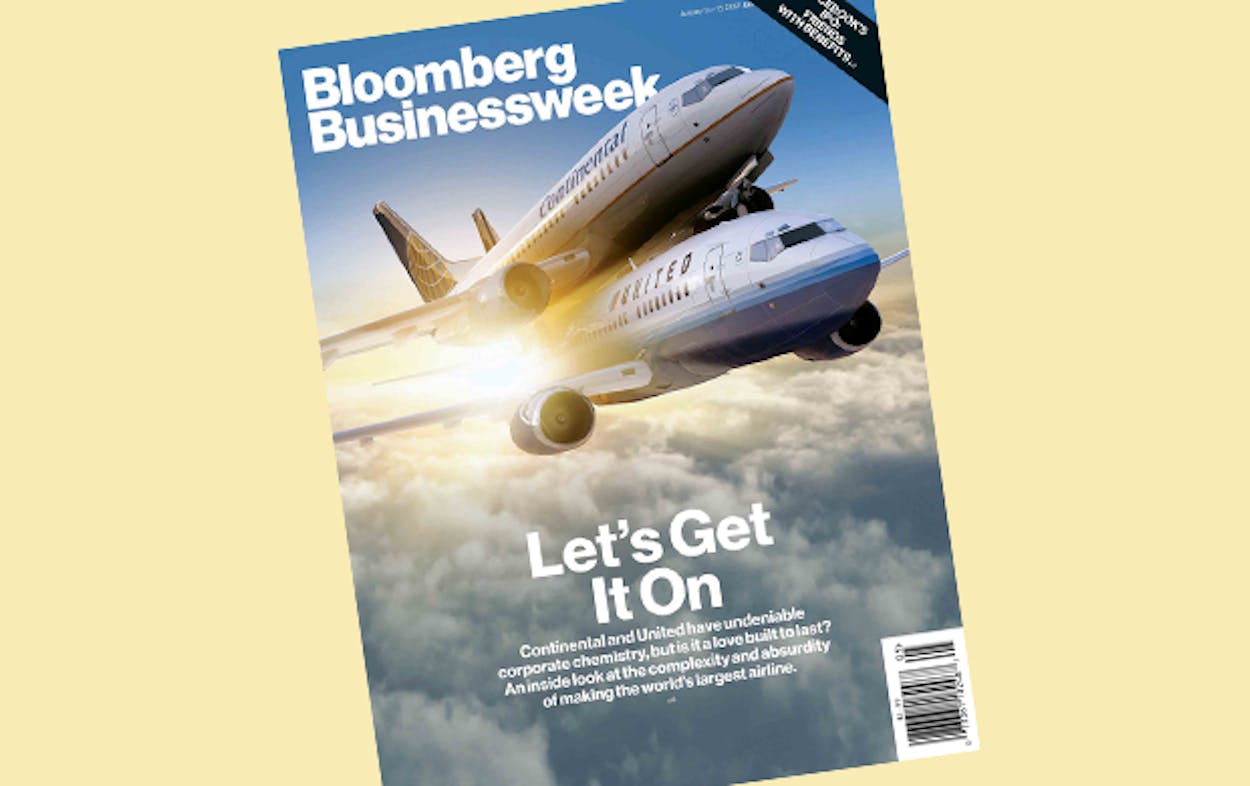All the talk about the new issue of Businessweek’s cover story about United merging with Continental airlines was, for obvious reasons, about the actual cover.
“Continental, United join mile-high club,” was the headline on Sarah Rufca’s Culture Map Houston story.
“Does it still suck to know that Houston is getting screwed out of a Fortune 500 company headquarters with the move to Chicago? Yes,” wrote Rufca. “Do I care when I look at this cover? Not in the least.”
“I mean this in the nicest possible way: It could have been a TEXAS MONTHLY cover,” tweeted the Texas Tribune‘s editor Evan Smith, who was, after all, the editor of TEXAS MONTHLY when the magazine published the “Astronaut Sex!” cover.
But what about the article? Drake Bennett explains what it took—and is still taking—to seamlessly merge two enormous companies and create the country’s largest airline. As Bennet notes, preconditions of the merger included calling the company United, putting Continental CEO Jeff Smisek in charge, and relocating the headquarters to Chicago from Houston.
“The company has spent the time since then trying to work out everything else,” he writes.
Part of working it out means examining how the two companies handle similar situations. For example, given the importance of coffee to flight passengers, Bennet opens the story by pointing out the difference between Continental’s (from a company called Fresh Brew) and United’s (Starbucks). Rather than adopt one airline’s method wholesale, the integrated company set up a fourteen-member tasting panel to try a dozen proposed blends, supervised by a vice president in charge of food services whose personal taste runs more towards mochas. (We won’t tell you how it ends.)
Among the smaller differences that had to be resolved were boarding style (Continental goes back-to-front, while United had been trying the window-middle-aisle), plastic cup shape, uniform options for male employees, and, most remarkably, (emphasis ours) “whether miniature ponies will be allowed, as they were on Continental, to travel in the cabin as service animals.”
A much bigger task than rewriting service animal guidelines is folding Continental’s Houston operations center into United’s, while still running both airlines every day. The employee supervising this project, Jim DeYoung, says he’s been treating it like “an O’Hare snowstorm.” A major factor, Bennett writes, is that the two companies have different algorithms regarding the cost-effectiveness of burning extra fuel for on-time arrivals versus rebooking costs from potential missed connections.
Another monster job was paring the 440 manuals describing everything that has to happen before, during, and after a flight down to 260 manuals. (More than five hundred employees worked on that project.)
How does it trickle down to customers? As anyone who already flies either airline knows, the ticketing systems and frequent flyer programs have remained completely separate. That will finally change “sometimes in the first week of March.” (Bennett notes that the non-specific time frame is deliberate).
The company may have an even longer way to go in terms of labor deals and cost-cutting. Bennett says there’s “near-universal agreement” that the new company will enjoy the benefits of merging regardless of how its contract negotiations with employees get resolved. But they need to get resolved for cultural reasons, especially since the old United was in constant turmoil. Continental, he notes, was “a far happier place” by comparison.
Read the whole thing here, including an 11-panel slide show. (And fortunately, the miniature ponies did not go unnoticed by illustrator Jennifer Daniel.)







